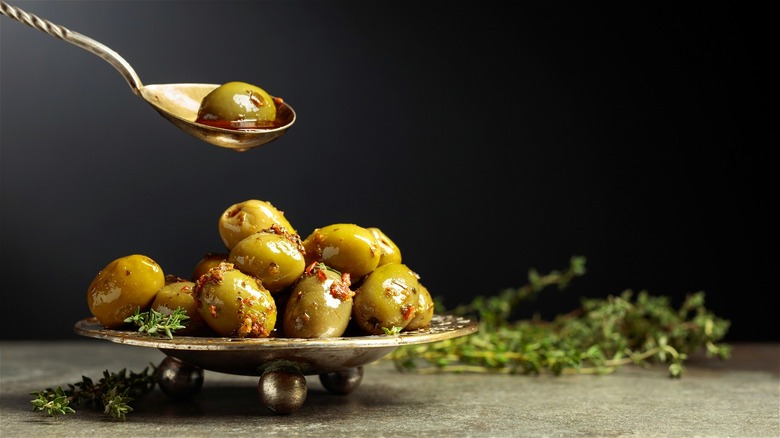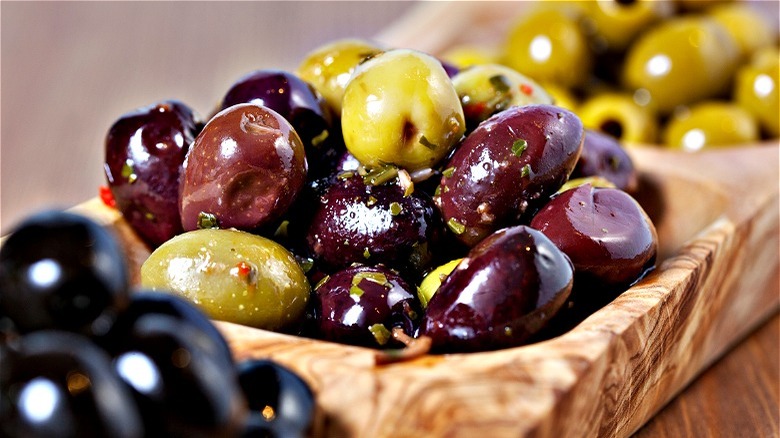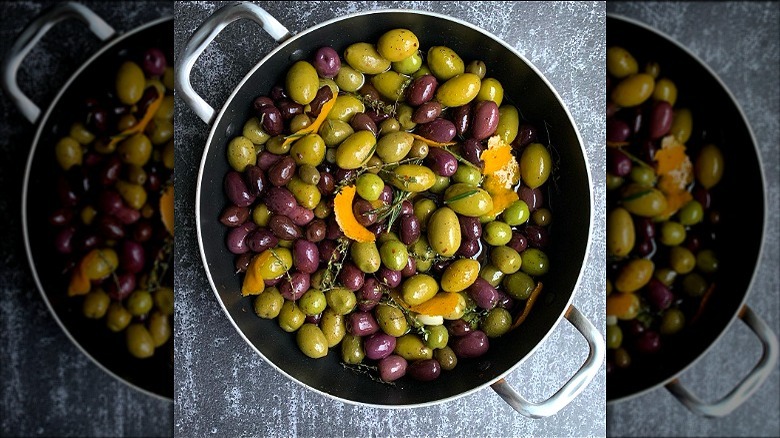The Warm Oil Trick To Make Olives A More Luxurious Snack
To resolve your mid-day salty snack craving, you could prep another round of at-home Chex mix, or reach for a healthier option and grab a handful of olives. According to Healthline, olives are a high-fat fruit rich in oleic acid and various minerals such as copper and Vitamin E. Olives have also been found to reduce your risk of inflammation, increase bone strength and fight against heart disease, based on one 2022 study outlining the impact of adequate monounsaturated fat consumption.
However, the olives we choose to snack on every day undergo significant processing to make them palatable to our taste buds. The International Olive Council describes how most table olives are treated with a variety of solutions to decrease the bitter flavor of oleuropein, a phenolic compound found in the olive plant. While FoodPrint. notes that olive oil is the number one product of this tiny bitter fruit, olives remain a popular snack of choice. Olive Oil Times claims olives have been consumed for thousands of years and were one of the first fruit trees pushed into mainstream cultivation. With olives serving their place as a tasty treat for many foodies around the world, there are certain ways of enjoying them that bring out their complex flavors. Before we unveil why heating your olives in oil is a good choice, let's discuss the most common ways of enjoying this unique stone fruit.
The most popular olive varieties and tasty ways to enjoy them
If you've ever wondered about the difference between green and black olives, they're separated by ripeness, regardless of which variety you choose to consume. According to MasterClass, green olives are usually unripe olives treated in a lye-based solution to remove any harsh flavors. Unlike green olives, the darker kinds tend to have a more mellow taste with less of that signature umami flavor that comes with many olive varieties. Tastes Better From Scratch outlines how to make the ideal snack tray offering the most popular suggestions for charcuterie board lovers. Among all the cured meats, dried fruit, and hard and soft cheeses, olives are recommended to provide another salty component to your platter. But which varieties work best?
Better Homes & Gardens showcases 12 of the most popular olive varieties you might want to add to your next tray of snacks like Kalamata, which has a very intense flavor perfect for pasta dishes, and Cerignola, which are better eaten on its own, showcasing a subtle mild flavor akin to an actual piece of fruit. Foodiosity claims the best foods to pair with saltier, brine-soaked olives are mild cheeses like Colby or Havarti, tuna, and even hard-boiled eggs. Whichever variety you decide to pick up and serve among those tiny piles of fresh fruit and crackers, you may want to consider heating your olives in oil to enhance their overall flavor.
Heat your next batch of olives in oil for extra flavor
Whether you prefer a warm, cold, or room-temperature bowl of marinated olives, make sure your homemade mixture includes olives with pits. Cook's Illustrated says that intact olives not only have a firmer texture but their flavor has a complexity within the flesh, undisturbed by any brine solution. Yet, if you're wanting to elevate the flavors of your olives, according to lifehacker, you should be heating them in oil to bring out their supreme flavor. The process is fairly simple. The outlet suggests adding your favorite olives to a saucepan with a good amount of olive oil, fresh herbs, citrus zest, and whole garlic cloves. Bring them to a boil and simmer on medium heat for five minutes. In detailing her recipe for warm marinated olives, Marcellina in Cucina describes how heating olives in oil brings out the hidden aromas and flavors within these small cured fruits.
If you're looking for specific directions in procuring a fancy bowl of warm olives, you can follow Ina Garten's recipe (via Food Network) featuring whole fennel seeds and strips of orange peel, or try your hand at Martha Stewart's recipe, which contains fennel and coriander seeds, and dried red chilis. Whichever herbs or spices you decide to use in dressing up your tasty olive mixture, for your next batch, try heating and decide if you can detect any markable flavor differences.


